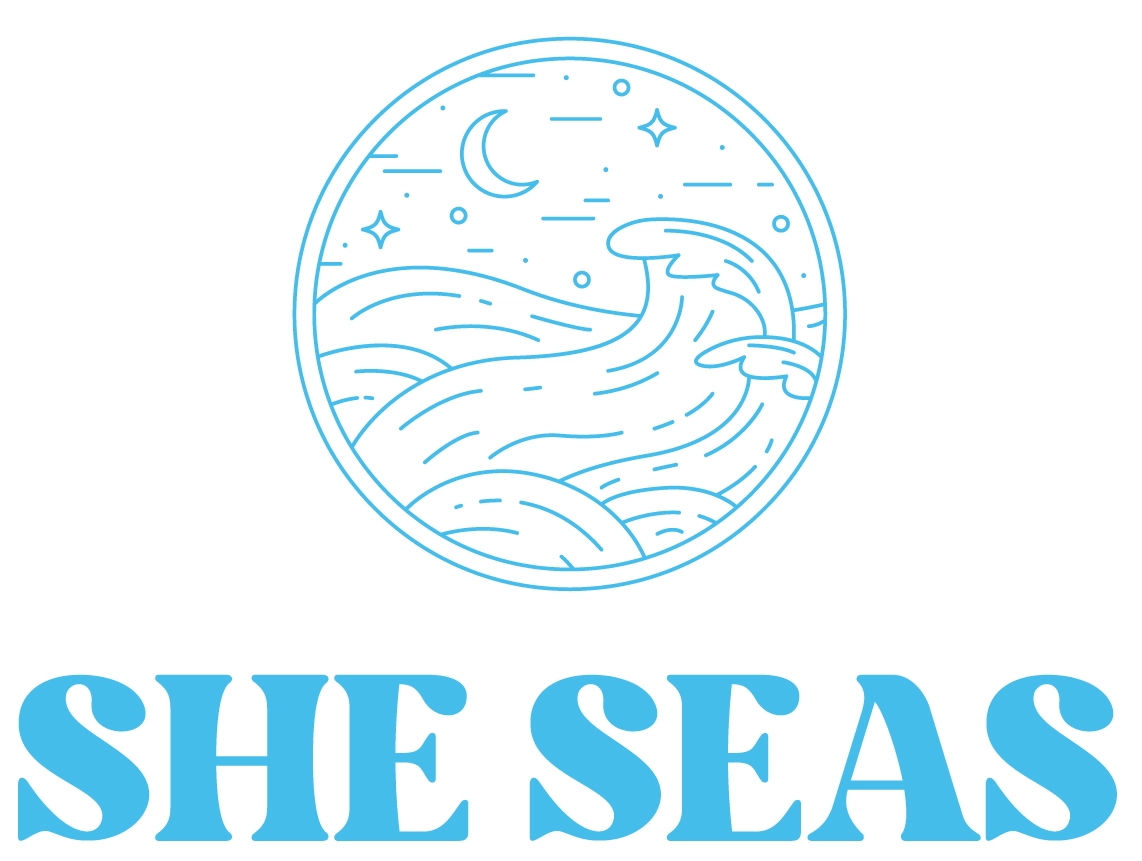Essential Boat Flags for Sailors and Boaters
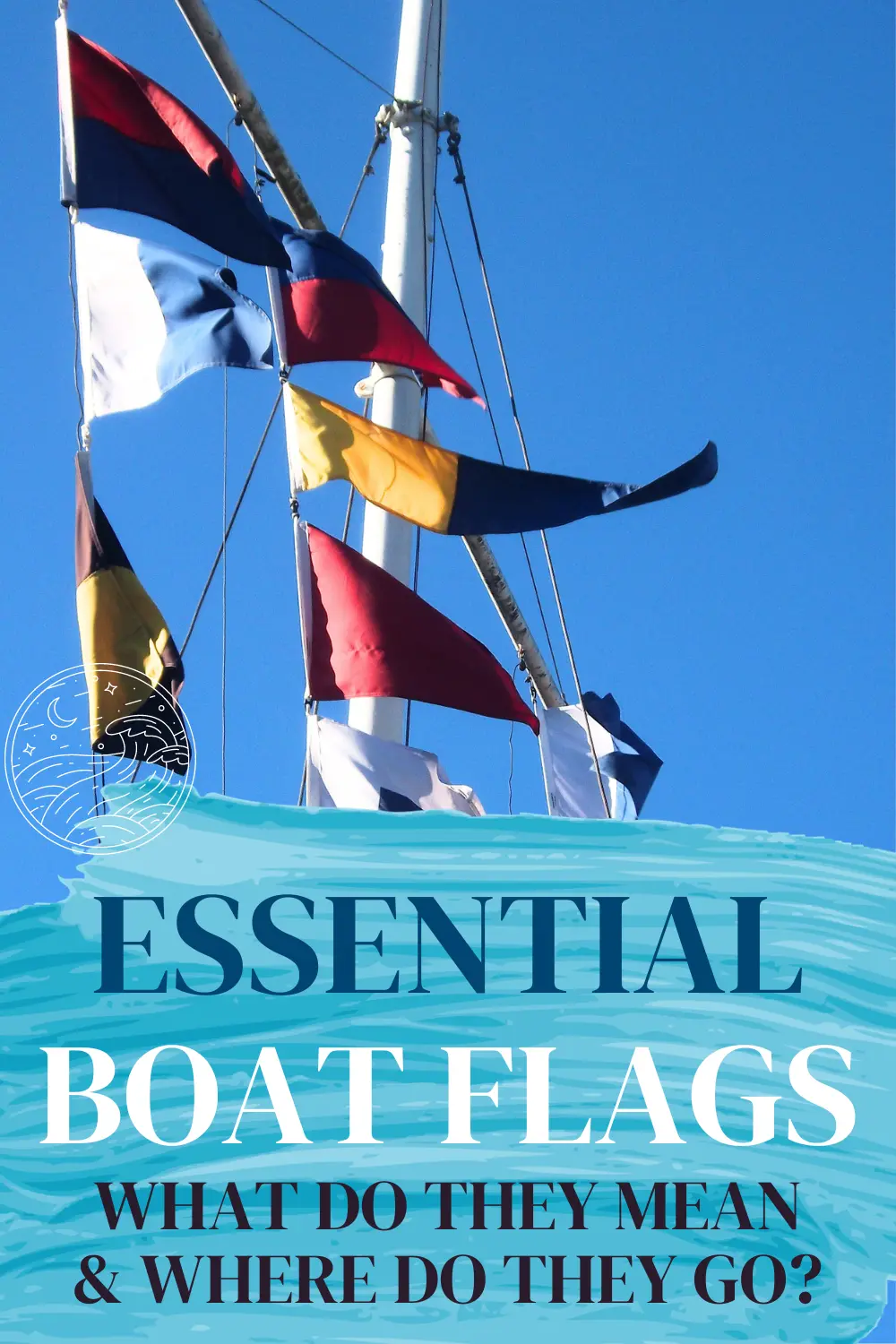
Boat Flags for Sailors
If you’re setting sail on the open seas, boat flags are more than just decorative touches—they’re an essential tool for communication. Understanding the importance of boat flags is key to ensuring safe and efficient communication with other vessels, marinas, and even countries.
In the world of sailing, flags have a long history and serve various purposes. From signaling your nationality to communicating safety or distress messages, boat flags are an internationally recognized way to share important information. While many sailors today rely on modern technology like radios and GPS, flags remain a crucial part of maritime tradition and functionality.
Below, I’m going to cover the common flags we use every day while sailing around the world, the color, and function.
Code Flags and the Phonetic Alphabet
One of the most fascinating aspects of sailing culture is the use of code flags and the phonetic alphabet to communicate messages across the water. These tools have been essential for sailors for centuries, allowing them to signal everything from navigation instructions to emergency alerts without the need for radios or spoken language.
Realistically, I’ve rarely seen code flags used for detailed communication with the exception of the flags I list below such as the “Q” Flag. The radio is the first and standard form of communication to other boats or to shore. However it’s still pretty cool to understand what they mean, and you never know if other communication fails, they could come in handy.
In addition to the standard meanings, you can also use code flags to spell out your boat’s name, signal fun messages, or even decorate your boat for special occasions.
Every code flag is related to a single letter in the phonetic alphabet. This alphabet is something that every sailor should know by heart so they can be clearly understood over radio. When I was learning the phonetic alphabet I used to make a fun game of spelling out signs or words I would see phonetically while I explored a new place. Like a sign for BURGERS – That’s Bravo – Uniform – Romeo – Golf – Echo – Romeo – Sierra!

A – Alpha
Divers Down

B – Bravo
I am taking in or discharging or carrying dangerous goods

C – Charlie
Affirmative/Yes

D – Delta
Keep Clear, I am maneuvering with difficulty

E – Echo
Altering course to starboard

F – Foxtrot
I am disabled, please communicate

G – Golf
I require a Pilot

H – Hotel
I have a pilot on board

I – India
I am altering course to port

J – Juliet
I am on fire and have dangerous cargo aboard; keep well clear of me

K -Kilo
I wish to communicate with you

L – Lima
You should stop your vessel instantly

M – Mike
My vessel is stopped and making no way through the water

N – November
No (negative)

O – Oscar
Man overboard

P – Papa
All aboard, vessel is about to proceed to sea

Q – Quebec
My vessel is healthy and I request clearing

R – Romeo
The way is off my ship, you may feel your way past me

S – Sierra
My engines are going full speed astern

T – Tango
Keep clear of me I am engaged in pair trawling

U – Uniform
You are running into danger

V – Victor
Require assitance (not in distress)

W – Whiskey
I require medical assistance

X – X-ray
Stop carrying out your intentions and watch for my signals

Y – Yankee
I am carrying mail / dragging anchor

Z – Zulu
I require a tug
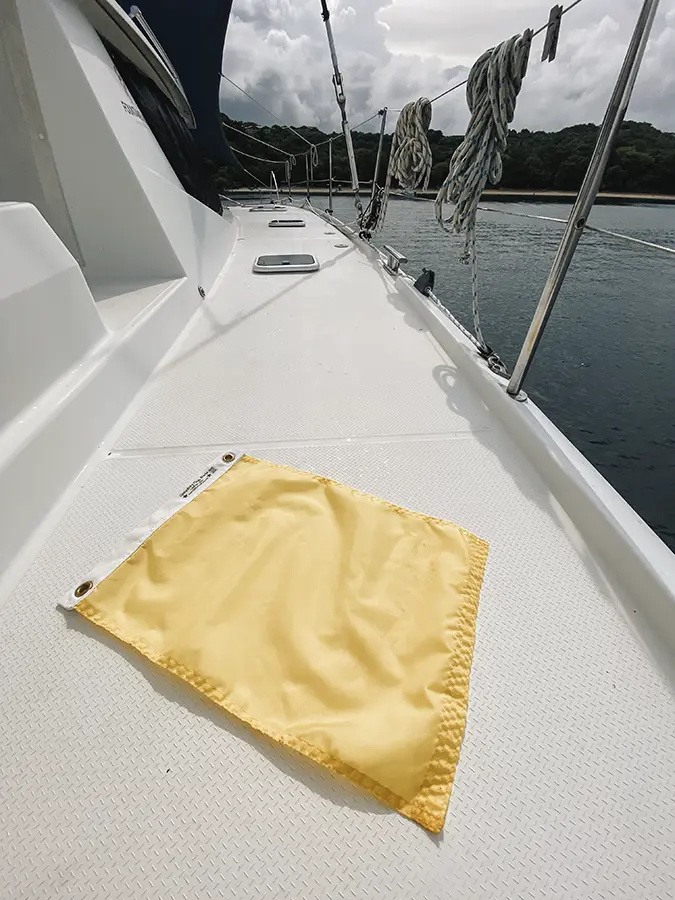
Q Flag (Yellow Quarantine Flag)
The Q flag, or yellow quarantine flag, is an essential for sailors traveling internationally. This flag signals that your boat is requesting clearance from local customs or immigration upon arrival in a new country. It’s flown from the starboard spreader and is used to indicate that your vessel has not yet been inspected or cleared by the local authorities.
The Q flag is raised when you enter a foreign port and must stay up until customs and immigration officials have either come aboard and cleared your crew and vessel, or you’ve gone ashore to those offices and cleared in. Once you’ve been given the all-clear, you can take down the Q flag and replace it with the courtesy flag of the country you’re visiting.
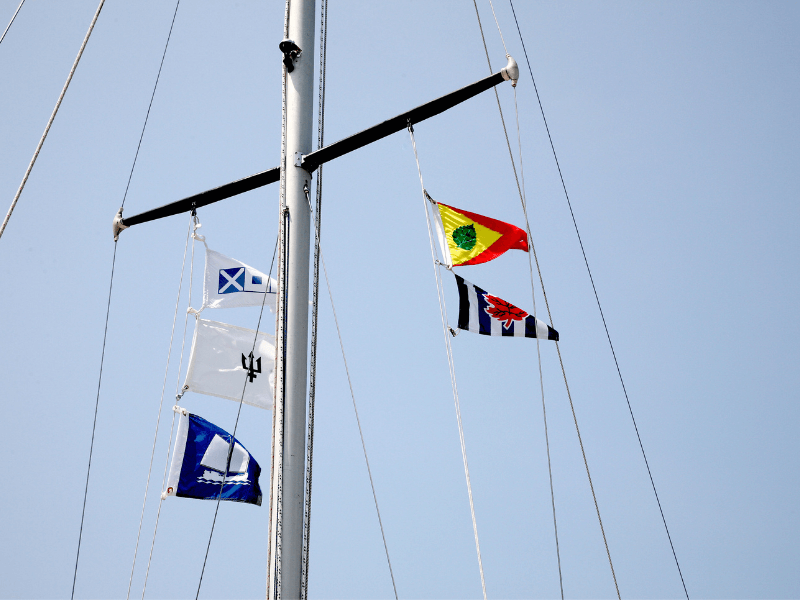

National Ensign Flag
The national ensign is the flag represents the country where your boat is registered, and it’s flown at the stern (back) of your vessel. Not only does it signify the nationality of your boat, but it’s also a legal requirement in some places, especially when entering foreign waters.
That being said, while we do have one onboard, we have never flown our national flag off the stern as we don’t want to take it down on every passage, and don’t want to worry about replacing it when it gets tattered. We’ve traveled throughout the Caribbean and Pacific and have never had any trouble. (This is not a recommendation to not fly it, it’s just what we’ve found.)
If you are sailing far from your home country however, it can be nice to signal to other liveabords from the same country that you’re here too and you have something in common.
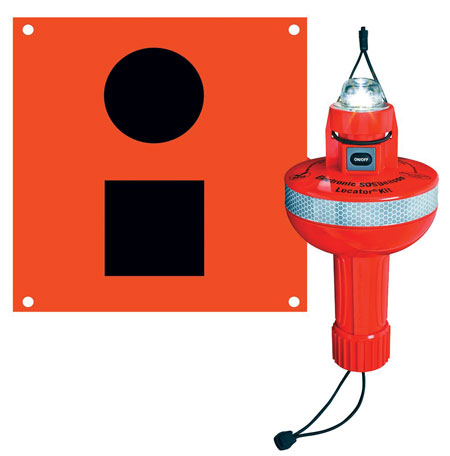
Distress Flags
While I hope you never have to use it, the distress flag is an important part of your onboard safety equipment. The most common distress flag is an orange flag with a black square and a black circle in the center. This flag is recognized internationally as a signal of distress and can be used to alert nearby vessels or rescue authorities that you’re in need of assistance.
In some situations, you might also use the Code Flag N flown over Code Flag C, which together signal that your vessel is in distress and needs help.
More important in my opinion however is having functioning safety equipment onboard such as orange smoke flares, rocket flares, an EPIRB, a handheld VHF, whistles, and airhorns, that you inspect and test regularly. These are more visible and/or something you can hear from farther away.
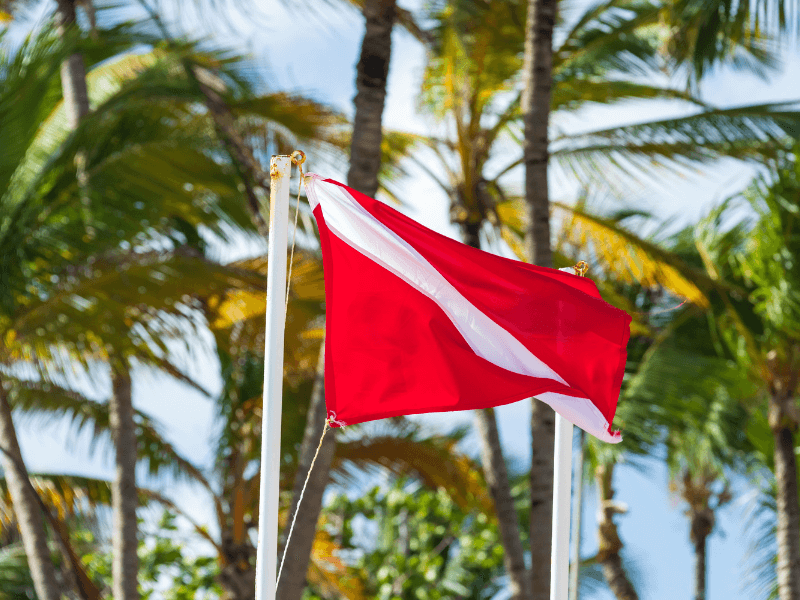
Diver Down Flag
If you or your crew plan to do any diving or snorkeling from your boat, you’ll need a diver down flag. This flag, which is red with a white diagonal stripe, signals to other vessels that there are divers in the water nearby. It’s flown to help prevent accidents, as it alerts other boaters to keep a safe distance from your vessel and be on the lookout for divers below or near the surface.
Flying the diver down flag is not just a courtesy—it’s often a legal requirement in many places, and any responsible captain or scuba crew should be flying one. Make sure to take the flag down once all divers are back on board and out of the water.
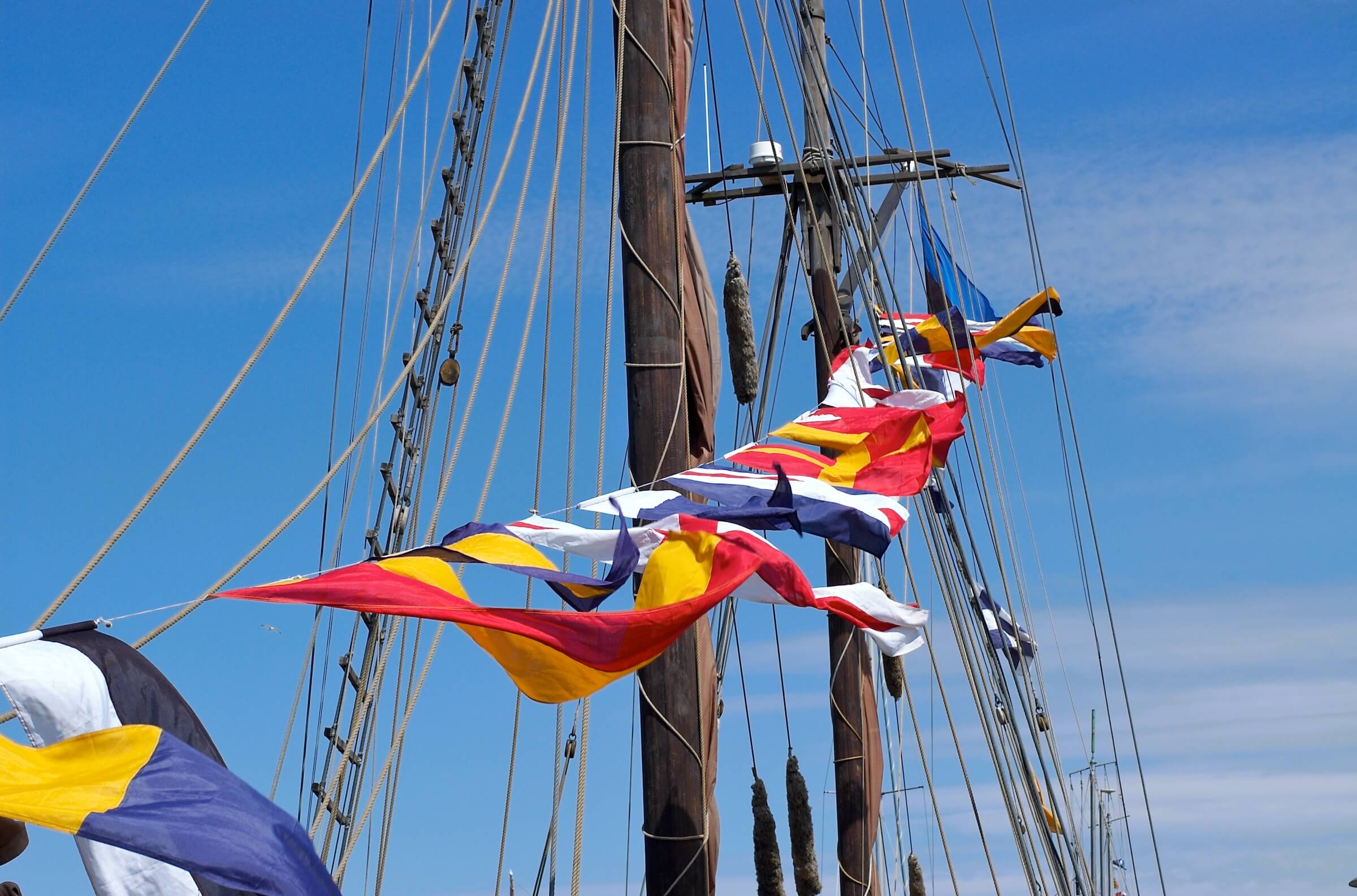
Having Fun with Boat Flags
Sailing isn’t just about serious communication—there are also plenty of opportunities to celebrate and have fun with flags! For example, during special holidays or events like regattas, or crew celebrations, sailors often “dress ship” by flying a series of colorful flags along the rigging of their boat.
These special occasion flags can include national flags, signal flags, or decorative banners and are a way to celebrate while adding a festive touch to your boat. For example, if it’s someone’s birthday you could write out their name in code flags, or raise all the country flags of a crew if you’re sailing with an international group. Dressing your boat with flags is a fun way to get into the spirit of the occasion.
Essential Boat Flags and the Art Nautical Communication
As you can see, boat flags are more than just accessories—they’re an essential part of the sailor’s toolkit. From the legal requirements to safety benefits, each flag has a specific purpose and meaning.
By understanding the significance of these flags and how to use them properly, you’ll be well-equipped to communicate with other sailors, marinas, and coastal authorities while respecting the traditions of maritime culture.
So, next time you set sail, be sure to stock your boat with these essential flags. Whether you’re cruising through international waters or just heading out for a day on the waves, having the right flags on board will keep you safe, legal, and stylish!
